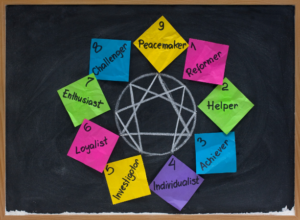Coupling the enneagram with Adoption and Foster Care
I have ten children with eight distinct personalities among them. One of them, whom I guess could be dubbed an “Enthusiast,” is always on to the next thing. He struggles with gluttony. He’s my tallest and thinnest son, but he has an insatiable appetite for more–of everything. Yesterday, headed to another day of middle school, he came through the kitchen and paused to give me a heartfelt hug. I’m not sure what I said because I was so shocked. Ever since I met him just shy of his third birthday, he has always been on the move. But yesterday, he stopped and chose to embrace me.
You’re probably awaiting the punchline. There isn't one. He didn’t even ask me for anything. So what’s the big deal? Why so shocked? He was, in this moment, a very different type of son than I’ve come to expect.
Of all the tools available to think about our own and our children’s personalities or types, the enneagram leads my list. I can genuinely say that it’s been life-giving in my relationship with all my kids. The enneagram is a self-discovery tool based on the premise that there are nine types of personalities that develop from how we adapted to the world in childhood, and that one type in particular, is dominant.

For me, the enneagram was a bit weird at first. It has ancient and slightly vague roots. Furthermore, it didn’t feel appropriate to reduce people to "numbers"–and only nine numbers at that. Really God, only nine? How can that be?
For instance, when I mentioned ten kids, nine types, with only eight personality types in the mix, you might now be wondering which one of the nine types our family is missing. Well, it appears we’re missing a "Type TWO", the “Helper.” Alas, had we only known the enneagram when we started our adoption journeys, we might have sought out a "Helper?!" 😉 Of course not! (But my husband and I do laugh about this often.)
However the deeper I dig, I am learning there are far more than nine types—there are 27 subtypes! (Don’t get me started about the countless variables beyond that!) The fun of these numbers is that they aren’t X-rays, but more like watercolors—low resolution pictures of our personalities where there are infinite shades of color. The balance necessary for "typing" our children comes through understanding the complexity in which we’re all made and becoming.
A quick disclaimer... Experts say we are not “supposed to” type our children. They also say children typically don’t discover their number until their twenties, BUT I do it anyway. I know, I know… not wise. Some may even say it’s dangerous—but I won’t deny I think about it. Once you understand the tool, it’s hard not to see these tendencies.
So there are three reasons why I think the enneagram can be a help to your family.
First, typing our children highlights and requires an important balancing act. When we put kids in the box of a certain type, we may restrict their growth, but at the same time, we also gain language to understand them and help them grow beyond their conscious and unconscious limitations. Ian Cron, author of The Road Back to You, depicts this balance quite well. (So well, in fact, that even my husband didn’t mind me reading aloud to him excerpt after excerpt.) According to Cron, the enneagram, as a tool, gives us a vernacular for describing ourselves and others around us. In addition, the real magic is that it gives us EMPATHY for ALL of those around us—even in those crazy-making moments with that child in your home who knows exactly which buttons to push.
A second reason for the high value of the enneagram is ironically, the reason I initially wrote it off—it made me feel exposed. I didn’t want someone else to “read my diary.” Discovering your type can make you feel vulnerable and perhaps blush a little as you dig into the different numbers. It’s no surprise that I am a ONE, the number that I like to call the “Reformer,” not the “Perfectionist.” I still have envy of the NINE, who is known as the “Peacemaker." I certainly agree with Cron who asks, “Why can’t they all have the label of a Beatitude?”
As a "Reformer," my focus tends to jump to all that is wrong in the world, and I am motivated to fix it. That can be noble—but that can also be horrific. We all know what it feels like to feel fixed by someone… not good. Boy, have I had to learn this, and am still learning this, in parenting ten children. However, despite this negative side of my type, the beautiful side is that I have also learned that being a "ONE" can also reflect the goodness of God, which lines up with having a heart for orphans. I like that reflection of my type! And, though feeling somewhat exposed in the self-discovery process, I’ve learned to own my positive and negative tendencies. I’ve actually had more grace for myself, something I tend to struggle with while I’m busy “reforming” myself and others.
The key to using the enneagram is to go from self-knowledge to self-application. It’s fun banter at a dinner party to discuss types and numbers, but it’s an entirely different experience to apply the information to the benefit of those with whom you live.
A third reason the enneagram has been beneficial is because each number depicts a "superpower" that manifests the traits of God, and I need to see God in and at work in my family. In fact, I need to intentionally look for Him when I’m overwhelmed. For example, Type ONEs show God’s goodness, TWOs love, THREEs glory, FOURs have eyes for beauty/suffering, FIVEs seek wisdom, SIXes are faithful, SEVENs exude joy, EIGHTs display power/justice, and NINEs bring peace.
Of course, there is also the “shadow” side where one particular sin can dominate. ONEs struggle with anger, TWOs pride, THREEs deceit, FOURs envy, FIVEs greed, SIXes fear, SEVENs gluttony, EIGHTs lust, and NINEs sloth. Yet in thinking about these types or numbers, I see God redeeming each of us.
My hope is that the enneagram will be of use to your family. It’s by no means a perfect tool. And, I repeat, experts advise waiting until children become adults to really determine an enneagram number. Kids grow and change! But the process of thinking about them and ourselves in a meaningful way is already well underway, regardless of their age. The enneagram will give you accessible language to think through who they are and are becoming.
In the adoption and foster care world, there is so often the additional layer as well—trauma. Trauma often trumps all of these numbers and "types." Often times, it is hard to see the true heart of a traumatized personality until their limbic system is rewired over years of healing. Even in this case, the enneagram has opened up hopeful dialogue with my teenagers about who they really are underneath the circumstances of their lives.
If your interest is piqued and you’re intrigued with this tool, here are links to resources that will get you started on the journey:
The Road Back to You, by Ian Morgan Cron and Suzanne Stabile
The Enneagram, A Christian Perspective, by Richard Rohr and Andreas Ebert
Typology, a podcast with Ian Morgan Cron
Martha Cook is the mother of ten children (5 adopted from Georgia (US), 2 from Ethiopia, and 3 biological). Martha has her Masters in Counseling. She thrives when she gets to encourage parents who are called to be a part of “setting the lonely in families.” Having experienced God’s abundant love for her and her family, she longs to share it with others. The Cooks live in Peachtree Corners, GA.



Rebecca Fitton
May 1, 2019 at 2:41 pmThanks for repeatedly bringing this topic into our conversations until I finally decided to take a look at it myself!!